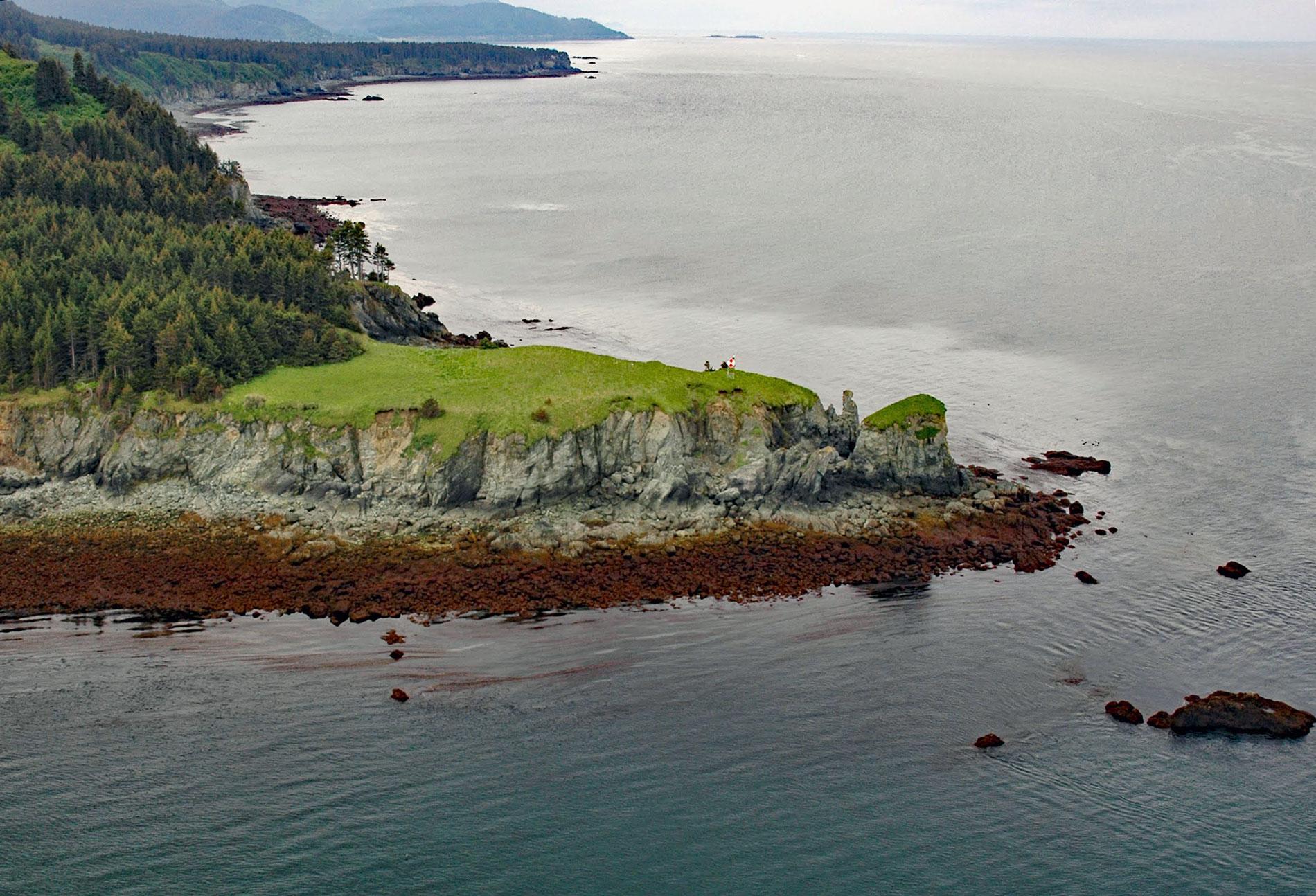Point Pogibshi is a prominent flat-topped grassy headland with rocky sides about 50 feet (15 m) high on the southern shore of Kachemak Bay, about 20 miles (23 km) southwest of Homer, and 5 miles (8 km) north-northeast of Nanwalek, Alaska. The point is the site of a navigational aid consisting of a light mounted on a skeleton tower with a diamond-shaped red and white daymark. The name is from the Russian for ‘Point Peril’ and was first published by the U.S. Coast and Geodetic Survey in 1943. The name probably refers to the wave eroded underwater platform that extends from the headland for about 0.5 miles (0.8 km) and this shallow reef is marked by a thick canopy of bull kelp. The headland also accelerates the strong tidal currents that flow into Kachemak Bay on the flood, and along the southern coastline, this current is often exacerbated by accelerated winds and wave-generated nearshore currents creating whirlpools and rips. The headland is formed by bedrock representing the Pogibshi formation that developed during the Early Jurassic time and is exposed at several locations on the east side of Cook Inlet. The formation consists of volcaniclastic rocks such as breccia, conglomerate, and sandstone that is interbedded with small amounts of limestone, coal, and tuffaceous argillite.
The U.S. Coast and Geodetic Survey ship Carlile P. Patterson charted much of Alaskan waters between 1883 and 1918. Various officers on the ship also took great interest in the ethnography of Alaska, as the Patterson operated in the traditional areas of Tlingit, Haida, Chugach Sugpiaq, Alutiiq, and Aleut peoples. Naval officer Albert P. Niblack who served two tours on the ship wrote The Coast Indians of Southern Alaska and Northern British Columbia, which was published through the National Museum of the Smithsonian Institution. In the late 1890s, hundreds of soundings were taken by the Patterson in Kachemak Bay with a Sigsbee machine in addition to making triangulation measurements and topographic surveys. One report from the Patterson deviated from the routine and noted that more than thirty varieties of wildflowers were found within an area of three or four acres at Point Pogibshi among them, sweet peas, violets, columbines, flags, water lilies, and others known usually to warmer climates and more southern latitudes, suggesting a possible micro-climate. Soundings were also taken at Point Pogibshi which extends about 0.5 miles (0.8 km) into the currents of Kachemak Bay causing severe turbulence and large waves that are hazardous for small boats. On January 30, 1999, the fiberglass long-line cod fishing vessel Kavkaz of 36 feet (11 m) iced up and capsized near Point Pogibshi. No sign was found of the crew by U.S. Coast Guard first responders. The fishing vessel Arizona was able to tow the overturned vessel to a beach near Port Graham where rescuers heard a knocking from inside the wreck. The crew, the brothers Anton Sanarov and Feodor (Fred) Sanarov were trapped beneath the overturned vessel until a hole was cut through the hull with a chainsaw almost a day later by the crew of the USCGC Roanoke Island.
Point Pogibshi marks the south end of a mapped line that extends north to Anchor Point and represents the western boundary of the Kachemak Bay Critical Habitat Area. The area is approximately 222,000 acres (89,840 ha) established in 1974 by the Alaska Department of Fish and Game to protect habitat areas crucial to fish and wildlife. The area is now also a shorebird reserve and an estuarine research reserve. In the mid-1980s, scientists from around the Americas were documenting serious population declines in shorebirds. This prompted the scientific community to develop the framework for a network of key sites to protect shorebirds and their habitats, resulting in the Western Hemisphere Shorebird Reserve Network. In 1995, Kachemak Bay was designated as a network site, and it was expanded in 2016 and now includes 232,461 acres (94,074 ha). In 1999, the bay was designated as a unit in the National Estuarine Research Reserve System, with more than 370,000 acres (149,733 ha) of diverse coastal ecosystems protecting marsh plants, marine algae, and animals, coastal communities, and fish habitat. Kachemak Bay is the largest of 30 reserves in the national program which focuses on long-term research, water-quality monitoring, education, and coastal stewardship. Daily management and oversight are provided by the Alaska Center for Conservation Science. Read more here and here. Explore more of Point Pogibshi and Kachemak Bay here:

